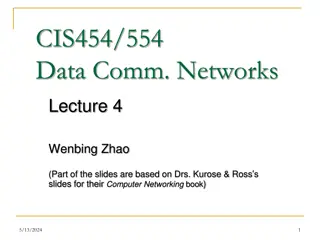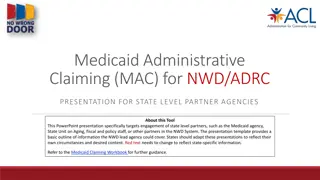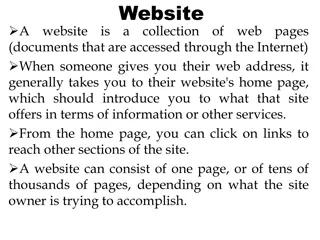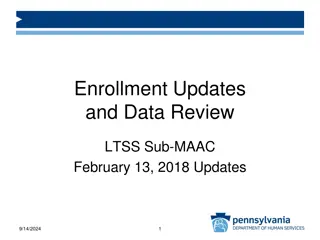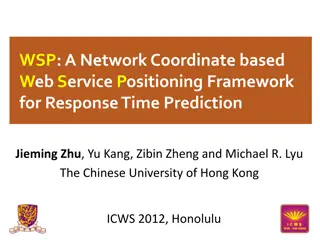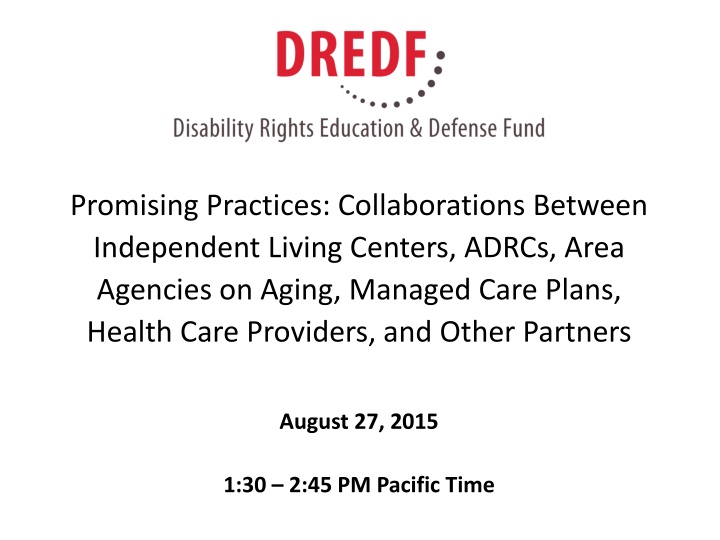
Collaborative Practices Between Aging and Disability Partners
Explore promising collaborations between independent living centers, ADRCs, health care providers, and more in the context of managed long-term services and supports for aging and disability populations. Learn about the establishment of partnerships, project funding, and key organizations involved in promoting effective care coordination and support services.
Download Presentation

Please find below an Image/Link to download the presentation.
The content on the website is provided AS IS for your information and personal use only. It may not be sold, licensed, or shared on other websites without obtaining consent from the author. If you encounter any issues during the download, it is possible that the publisher has removed the file from their server.
You are allowed to download the files provided on this website for personal or commercial use, subject to the condition that they are used lawfully. All files are the property of their respective owners.
The content on the website is provided AS IS for your information and personal use only. It may not be sold, licensed, or shared on other websites without obtaining consent from the author.
E N D
Presentation Transcript
Promising Practices: Collaborations Between Independent Living Centers, ADRCs, Area Agencies on Aging, Managed Care Plans, Health Care Providers, and Other Partners August 27, 2015 1:30 2:45 PM Pacific Time
Welcome Housekeeping To access captioning: For MAC users click on Media Viewer in the lower right hand corner For WINDOWS users click on Media Viewer in the upper right hand corner 2
Windows Closed Captioning in Media Viewer Closed captioning is available in Media Viewer. You can read a transcript of the Web Forum in real time!
Windows Closed Captioning in Media Viewer On the bottom right corner of your screen, click Show/Hide Header.
Windows Closed Captioning in Media Viewer During the course of the presentation, another window may cause the Media Viewer to collapse. This may happen during a Poll, for example.
Windows Closed Captioning in Media Viewer Click this icon to bring back the Media Viewer with the closed captions.
Welcome Housekeeping We will take questions at the end of the presentation Type your questions in the chat box The webinar transcript and slides will be available following the webinar on the DREDF website dredf.org 7
Aging and Disability Partnership for Managed Long Term Services and Supports Established by the National Association of Area Agencies on Aging (N4A) as part of a project funded by the Administration for Community Living (ACL) Project partners: National Disability Rights Network Justice in Aging Disability Rights Education and Defense Fund (DREDF) Health Management Associates (HMA) 8
Aging and Disability Partnership for Managed Long Term Services and Supports Project goals: Leverage the aging and disability networks extensive infrastructure, service capacity, and expertise to ensure delivery of high quality managed long-term services and support to seniors and people with disabilities 9
Webinar Series Purpose Purpose: To share three promising practices that feature collaborations between Independent Living Centers, ADRCs, AAAs, Medicaid managed care plans, and healthcare providers FREED and ADRC Grass Valley, California Center for Independent Living, Alameda Alliance Health Plan, LifeLong Medical Care Berkeley, California Access to Independence and Care1st Health Plan San Diego, California 10
Webinar Series Goals Goals: To illustrate how collaborations between ILCs, ADRCs, AAAs, Medicaid managed care plans, healthcare providers, and other partners Infuse IL philosophy and services into M/LTSS Improve health outcomes for seniors and PWD Increase community integration and participation for seniors and PWD Have the potential to generate cost savings 11
Agenda Introduction to collaboration between AAA and FREED of rural Nevada County, California to form ADRC Care Transitions Intervention (CTI) Integrated Care Coordination for Family Wellness (No Wrong Door) Care Transition Coaching Patient Navigation Outcomes Data needs Looking to the future 12
Presenters Ana Acton Senior Attorney Executive Director DREDF FREED Berkeley, California Grass Valley, California Mary Lou Breslin Pam Miller Senior Policy Advisor Executive Director DREDF Area 4 Agency on Aging Berkeley, California Sacramento, California Silvia Yee 13
Aging and Disability Resource Connection of Nevada County
ADRC of Rural Nevada County The vision to create the ADRC of Nevada County began over 15 years ago through the Long Term Care Implementation Council (LTC) The ADRC is a collaboration between FREED and A4AA, and other providers of long term services and supports (LTSS) and safety net services Goal: streamline access to LTSS for people with disabilities 15
ADRC Core Partners FREED and the Agency on Aging Area 4 (the AAA) are the two core partners The Leadership Team is made up of the Executive Directors of FREED, which serves as the lead and fiscal agency, and the Agency on Aging Area 4 16
New Services for Nevada County Options Counseling: Partner organizations have had staff trained in a person-centered model of service to assist individuals to plan for LTSS needs Care Transition Intervention: Collaboration between Sierra Nevada Memorial Hospital (SNMH), FREED, Western Sierra Medical Clinic (WSMC), and Community Recovery Resources (CoRR) to decrease hospital readmissions Community Transition: Money Follows the Person, California Community Transitions ~~~~~~~ A person-centered system respects and responds to individual needs, goals and values. 17
ADRC Consumer Demographics Consumer Age Over 60 - 1813 Under 60 - 224 Age Unknown - 263 Consumer Disabilities Physical - 470 Intellectual/Developmental - 14 Mental Health - 41 Multiple 118 TBI 7 Dementia 3 No Disability - 254 Unknown - 1373
Combined Program Data Formal Partnerships 13 Consumer Contacts with the ADRC 21,328 All consumers served 2300 Consumers served in 3 program Options Counseling = 51 Skilled Nursing Facilities transitions = 38 Sierra Nevada Memorial Hospital Transitions = 76
Strengths of Collaboration Independent living philosophy and services as integral to LTSS Strength of combined resources for improved, coordinated system in a rural area Shared vision, values, and goals Consumer driven perspective Coordinated leadership Cross training, streamlining LTSS Disability and older adult groups learning from one another Strong relationship between non-profit, for-profit and government 20
CTI: Care Transitions Intervention Reducing Readmissions
Barriers to Care In a rural, managed care environment, long waits for primary care, limited access to specialty care Individuals with disabilities, chronic illness, and complex health conditions frequently require care from multiple settings Many patients have limited ability to navigate the care delivery system 22
Barriers to Care Individuals who are chemically dependent and low-income are not typically connected to any primary care and preventative services The hospital, especially the ED, frequently becomes the focal point in the health care system when care is poorly coordinated and when individuals do not have access to preventative services 23
Partnership: Care Transitions Intervention (CTI), Nevada County, California August 2012: ADRC launches CTI with FREED, Sierra Nevada Memorial Hospital Goal: Reduce hospital readmissions, ED visits Objective: Help the patient and family caregivers gain knowledge, skills, and ability to identify resources to prevent future decline and hospital readmission Project duration: August 2012 present Initial Funding: State Independent Living Council 24
Four Pillars of CTI 1. Medication Self Management 2. Personal Health Record 3. Follow-up Appointment(s) 4. Know the Red Flags 25
Identification of Participants Medicare beneficiaries with disabilities, chronic conditions (heart attack, heart failure, pneumonia, COPD, stroke) including mental health/substance use disorder Other highest users of emergency department (ED) Others with highest hospital readmission rates People in need of community services and primary care 26
Intervention Strategies Care Transition Coaching and Referral Improvements Staff availability affects service capacity Coaching (1 FTE) FREED CTI Trained Coach Receives referral from hospital Office space at the hospital Sees patient while they are in the hospital Visits patient in their home Contacts patient 3 additional times via telephone 27
Intervention Strategies Referral Improvements FREED dedicated staff member Increased patient/client trust New referral form with specific needs and partners identified Improved data collection systems-Cirner Shortened first contact time Added patient phone number for contact after discharge 28
CTI Participation 451 Referrals 2013 = 280 2014 = 136 2015 (6 months) = 35 141 people completed the CTI Program 2013 = 82 2014 = 46 2015 (6 months) 35 Differences in referrals and number who completed the program year to year owed to staffing levels 29
CTI Preliminary Outcomes Readmission tracked for 30 days after discharge Ave. 7% Readmission rate 2013 = 7% 2014 = 6.5% 2015 (6 months) = 7% Sierra Nevada Memorial Hospital overall readmission rate for all patients during 30 days after discharge = 10% to 10.7% 30
Client Story 31
Promising Practice: Integrated Care Coordination for Family Wellness January 2014 -- Integrated Care Coordination for Family Wellness Collaboration: FREED, Dignity Health Foundation, Community Recovery Resources, and Western Sierra Medical Clinic Care Transition Intervention Program Patient Navigation by 3 organizations Goal: coordinate care (LTSS) across multiple settings support after discharge from the hospital appropriate patient navigation between primary medical services, disability and senior services, substance use treatment, and behavioral health services. 32
Barriers to Care Individuals with disabilities, chronic illness, substance abuse, and complex health conditions same barriers as for CTI, with an emphasis on: lack of trust in service providers and organizations homelessness mental health/behavioral issues Long wait times for primary care appointments for Medicaid (Medi-Cal in California) beneficiaries 33
Poor Care Transition Affects Health and Readmissions Poor care transitions often associated with hospital readmissions and ED visits Research documents lower patient satisfaction and rising healthcare costs due to: medication errors poor communication/coordination between providers from inpatient to outpatient settings preventable adverse events post-discharge 34
Care Transition Coaching and Patient Navigation No Wrong Door Care Transition Coaching and Patient Navigation between organizations and services enables a "no wrong door" system of referral and care across organizations Goal of securing a primary care appointment before discharge 35
Services Expanded to Include Patient Navigation June 2014--FREED and SNMH develop a second agreement to expand services to include Patient Navigation. August 2014, the CTI Coach secured dedicated workspace and spends part of each day at Sierra Nevada Memorial Hospital 36
Patient Selection Criteria Same as for CTI Medicare beneficiaries with disabilities, chronic conditions (heart attack, heart failure, pneumonia, COPD, stroke) including mental health/substance use disorder Other highest users of emergency department (ED) regardless of source of insurance Others with highest hospital readmission rates regardless of source of insurance People in need of community services and primary care 37
Patient Navigation Preliminary Project Outcomes 2015 46 Patient Navigation Referrals WSMC = 18 CoRR = 5 FREED = 6 SNMH = 17 Measuring readmissions and ED recidivism None within 30 days post-discharge 38
Client Story 39
Potential Return on Investment Average community with 50,000 beneficiaries, Medicare could save $4 million annually on hospital readmission costs for every $1 million spent on community-based interventions* Medicare ROI = 300%; (Gains Cost)/Cost Penalties: Maximum 0.62%** of regular Medicare reimbursement rate *www.californiahealthline.org/articles/2013/1/23/communitybased-care-reduces- readmissions-cuts-costs-study-finds.aspx#ixzz2JOKPaVhj ** http://www.kaiserhealthnews.org/Stories/2012/October/03/medicare-revises-hospitals- readmissions-penalties.aspx 40
Cost Savings? Would CTI provide a cost savings for individuals other than those on Medicare who have the 4 diagnoses that are associated with high readmission rates? Readmissions from ED visits? Managed Care and MediCal patients? Savings from long term increase in capacity and efficiency of community-based LTSS? Other consumer outcomes from increased LTSS in the community? 41
Data Needed Baseline hospital readmission and ED visit rates HIPPA Compliant Agreement for sharing hospital readmission and ED visits data Data tracking capacity including: Name Date(s) for hospital readmission and ED visits Diagnosis for hospital readmission and ED visits Consumer satisfaction w/ increased LTSS Additional consumer identified LTSS needs 42
Looking Ahead Trained CTI Coach Use of improved referral process Rural Expansion of MediCal Managed Care Move to managed LTSS Nevada County Health Coalition Collaboration Continued collaboration between FREED, SNMH, and CoRR Outcomes for Patient Navigation Might eclipse CTI as possible best practice Identification of on-going funding 43
Questions? Please take this opportunity to type your questions in to the CHAT box while we bring up a few of the questions that have been asked so far.
Nevada County Mandatory Medicaid managed care since 2013 Choice of two manage care organizations (MCOs) Not currently a managed long-term services and support county (MLTSS) CA has instituted MLTSS in 7 of the state s most populated counties
Proposed Medicaid Managed Care Rule On July 1, CMS proposed its first major revision of Medicaid managed care since 2002 Medicaid has grown, MCO delivery of Medicaid has substantially grown, and there is now significant MLTSS across the country The proposed rule attempts to regulate this new landscape Not final 60 day comment period closed
Rule - MLTSS Principles The proposed rule incorporates existing 2013 Guidance from CMS that set out 10 MLTSS Principles, including the enhanced provision of home and community-based services in accordance with the Supreme Court s Olmstead decision, and person-centered needs assessment and service planning 1st time definition of MLTSS quite broad
Rule - Care Coordination 438.208(b)(2) expands MCO coordination obligations by requiring: Coordination between care settings and with services provided outside of the MCO, including fee-for-service Medicaid benefits such as LTSS Potentially may set an additional standard to require community or social support services
Rule - Network Adequacy For the first time, the rule requires states to develop standards on the adequacy of Medicaid MCO provider networks, including LTSS providers when part of the MCO network ( 438.68 (2)) Currently time and distance standards when consumers travel to the LTSS provider, and other kinds of standards when LTSS providers travel to the consumer It is unclear how ADRC services would be categorized, or when they would be sufficient LTSS subcontractors accountability and data
Rule - LTSS Provider Credentialing The proposed rule newly establishes a credentialing and recredentialing requirement for the providers that enter MCO contracts or participation agreements, including LTSS, behavioral, and substance use disorder providers Big potential impact on community-based LTSS providers who work with Medicaid beneficiaries now and want to do so under managed care

